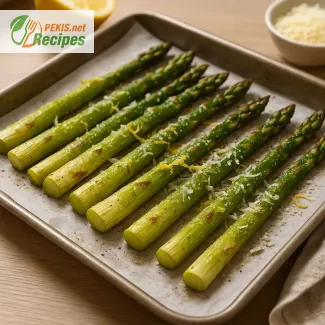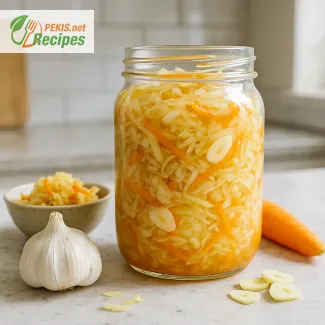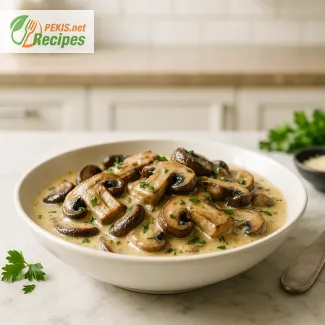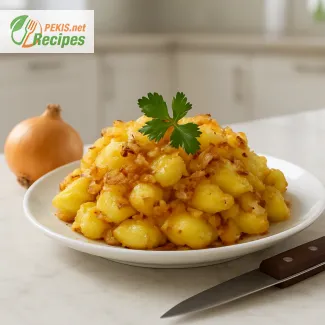
Discover the Perfect Way to Roast Asparagus with Fresh Lemon and Parmesan
A simple, elegant side dish that highlights seasonal ingredients
When spring rolls around and asparagus is at its peak, there’s no better way to enjoy this slender green vegetable than by roasting it to perfection. This easy roasted asparagus recipe with lemon and Parmesan captures everything we love about seasonal cooking: fresh flavors, vibrant colors, and just the right touch of indulgence. The high-heat roasting process caramelizes the tips, giving them a subtle crunch, while the lemon zest adds brightness and the grated Parmesan brings in a savory richness.
The beauty of this recipe lies in its simplicity. It requires minimal prep time, just a handful of ingredients, and delivers restaurant-quality results right from your own kitchen. Whether you're hosting a dinner party or preparing a quick weekday meal, roasted asparagus makes a versatile side that pairs beautifully with roasted chicken, grilled salmon, creamy risottos, or even a soft-boiled egg and toast for brunch.
Why roasted asparagus is a kitchen staple
Asparagus has long been a favorite among chefs and home cooks alike for its delicate flavor, fast cooking time, and nutritional benefits. But when it comes to texture and taste, roasting is one of the best ways to prepare it. Roasting transforms asparagus from mildly vegetal to deeply savory, intensifying its earthy notes and allowing the edges to crisp while the centers remain tender.
What elevates this recipe even further is the combination of fresh lemon juice, extra virgin olive oil, and finely grated Parmesan cheese. The citrus brightens every bite, cutting through the natural umami of the asparagus, while the Parmesan adds a rich layer of flavor that complements the toasty finish.
Unlike steaming or boiling, roasting preserves the asparagus’ vibrant green hue and avoids sogginess. This makes it not just a tasty option but a visually appealing one—perfect for plating alongside your favorite main dish or serving on a platter at a holiday gathering.
Choosing the right asparagus and preparation tips
To achieve the perfect roasted asparagus, start by selecting fresh, firm stalks. Ideally, the spears should be straight, with tightly closed tips and minimal dryness at the base. Thinner spears tend to cook faster and offer a more delicate bite, while thicker spears develop a meatier texture when roasted.
For even cooking, trim the woody ends of the stalks—usually about 2 to 3 cm from the bottom—either by snapping them naturally or slicing with a knife. Then lay the spears in a single layer on a parchment-lined baking sheet, ensuring there’s enough space between them to roast evenly without steaming.
A light drizzle of olive oil is essential to promote browning and prevent drying. Don’t forget to season with sea salt and a dash of black pepper before placing the tray in the oven. Once cooked, a sprinkle of lemon zest and fresh juice awakens the dish, while a final dusting of Parmesan ties everything together with a salty, savory note.
Serving ideas and variations
Roasted asparagus is endlessly versatile. For a touch of indulgence, try shaving pecorino romano over the top instead of Parmesan. You can also add crushed garlic, toasted pine nuts, or a spoonful of hollandaise sauce to take it in a different direction. If you're preparing a brunch spread, serve roasted asparagus over toasted sourdough with a poached egg and a drizzle of truffle oil.
For a heartier option, toss the roasted spears with pasta, sun-dried tomatoes, and a splash of cream for an easy springtime meal. Or combine them with other roasted vegetables such as carrots, fennel, or cherry tomatoes for a warm salad that’s full of color and depth.
Another excellent variation includes wrapping the spears in prosciutto before roasting—a popular appetizer that combines crisp, salty meat with the tender crunch of asparagus.
Storing leftovers and reheating tips
If you happen to have leftovers, store the roasted asparagus in an airtight container in the refrigerator for up to three days. While it’s best enjoyed fresh, you can reheat it gently in a skillet over medium heat or in a preheated oven at 180 °C (350 °F) for 5–7 minutes. Avoid microwaving, as it can lead to a mushy texture.
You can also chop leftover spears and stir them into scrambled eggs, frittatas, or quiches for a quick meal the next day. Alternatively, slice them into pieces and toss into a grain bowl with quinoa, chickpeas, and tahini dressing for a nutritious lunch.
Key ingredients that make the difference
This recipe showcases how just a few ingredients—fresh asparagus, lemon, olive oil, and Parmesan—can come together in perfect harmony. The secret lies in quality. Choose the best extra virgin olive oil you have on hand, freshly grated cheese rather than pre-shredded, and unwaxed lemons if you plan to use the zest.
For those who prefer plant-based options, the Parmesan can be substituted with a dairy-free alternative or simply omitted. The result remains equally delicious, thanks to the roasted flavor and citrus accent.
Roasted asparagus with lemon and Parmesan is more than a side dish—it’s a celebration of seasonal simplicity, perfect for spring and summer cooking.
- Preheat the oven to 200 °C (400 °F).
- Wash the asparagus under cold water and pat dry thoroughly with a clean towel.
- Trim the woody ends of the asparagus (about 2–3 cm / 1 inch from the bottom).
- Line a baking sheet with parchment paper and arrange the asparagus in a single layer.
- Drizzle the olive oil evenly over the asparagus.
- Sprinkle with sea salt and black pepper. Toss gently with your hands to coat.
- Roast the asparagus in the preheated oven for 12–15 minutes, or until the tips are slightly crisp and the stalks are tender.
- Remove from the oven and immediately zest lemon over the hot asparagus.
- Squeeze the fresh lemon juice over the asparagus for brightness.
- Finish by sprinkling grated Parmesan over the top. Serve immediately while warm.
Creative Twists to Elevate Your Roasted Asparagus Dish
Flavor upgrades, healthy swaps, and kitchen-tested improvements
Roasted asparagus with lemon and Parmesan is already a delightful side dish, but with a few thoughtful adjustments, it can be transformed into an even more flavorful, balanced, and personalized experience. Whether you're looking to enhance texture, deepen umami, or cater to specific dietary needs, this guide provides expert-level tips to enrich your next asparagus preparation.
How ingredient swaps affect the final flavor
The base recipe calls for olive oil, lemon, and Parmesan cheese, which together create a beautifully balanced mix of acid, fat, and salt. However, experimenting with a few select ingredients can dramatically shift the flavor profile:
- Swap Parmesan for pecorino if you want a sharper, saltier finish. Pecorino Romano adds more intensity and works well for those who prefer bold flavors.
- Add garlic powder or minced fresh garlic before roasting for a stronger, more aromatic kick that complements the roasted spears.
- A sprinkle of toasted breadcrumbs or crushed nuts like almonds or hazelnuts adds a pleasing crunch and nutty undertone, enhancing both texture and complexity.
- Replace lemon juice with balsamic glaze for a sweet-and-savory depth. Balsamic roasted asparagus creates a more luxurious taste that pairs well with red meats or earthy grains.
These small substitutions allow for impressive versatility without overwhelming the natural essence of asparagus.
Benefits of homemade over store-bought alternatives
Making this dish at home offers more than just freshness—it ensures control over ingredients, fat content, and portion size. Pre-made asparagus sides often contain preservatives, excess sodium, or low-quality oils. In contrast, a home-cooked version gives you the ability to:
- Choose high-quality extra virgin olive oil, preserving its heart-healthy benefits.
- Adjust seasoning precisely to suit your taste or dietary requirements.
- Use organic or locally sourced asparagus for maximum nutritional value.
Homemade preparation also means serving the dish at its peak—hot, crispy, and with just-melted cheese—rather than lukewarm and soggy, as it might be after packaging or reheating.
Common mistakes to avoid for perfect results
Roasting asparagus might sound simple, but it’s easy to fall into a few common traps:
- Overcrowding the pan: This prevents proper roasting and causes steaming instead, which results in limp and soggy stalks. Always roast in a single layer with space between spears.
- Skipping the trimming step: Not removing the woody ends leads to a chewy texture that detracts from the overall eating experience.
- Using too much oil: While some fat is necessary, overdoing it can drown the asparagus and make it greasy. A light drizzle is all you need.
- Overcooking: Thin asparagus cooks in as little as 10 minutes at high heat. Leaving it too long can result in mushy, stringy texture and a dull green color.
By avoiding these mistakes, you retain the vibrant color, crisp texture, and balanced flavor that make roasted asparagus so appealing.
Healthier alternatives and diet-friendly tips
To make this recipe even more suitable for specific dietary preferences, consider the following options:
- Vegan adaptation: Replace Parmesan with nutritional yeast or a plant-based grated cheese to maintain the umami quality while keeping the dish dairy-free.
- Low-sodium version: Omit the cheese and use only lemon juice, garlic, and a pinch of herbal salt substitute for a lighter, cleaner flavor.
- Low-fat option: Reduce the olive oil by half and finish with a squeeze of lemon and fresh herbs like dill or parsley instead of cheese.
These tweaks not only cater to various health needs but also preserve the vibrant taste and crisp texture that define this dish.
Seasonal variations and pairings
Spring is asparagus season, but the preparation can adapt year-round. In colder months, consider adding warming spices like smoked paprika or chili flakes for a cozy twist. During summer, pair the roasted asparagus with grilled peaches or fresh burrata for a bright and refreshing appetizer.
As a side, this dish pairs exceptionally well with:
- Herb-roasted chicken or lemon thyme salmon
- Creamy polenta or mashed cauliflower
- Poached eggs or a sunny-side-up egg for a brunch-style plate
Each pairing can shift the mood of the dish—casual, elegant, comforting, or refreshing—based on the occasion and the season.
When simplicity meets sophistication
At its core, this dish celebrates fresh ingredients prepared with intention. But small changes—whether through bold toppings, healthy alternatives, or mindful technique—can elevate your roasted asparagus from a simple weeknight side to a gourmet centerpiece. The flexibility of the recipe allows it to shine on any table, in any season, for any diet.
Allergens present in the recipe:
- Milk (Parmesan cheese)
Contains gluten:
- No, this recipe is naturally gluten-free.
Suggestions to remove allergens:
- Replace Parmesan cheese with a dairy-free hard cheese alternative to make the dish completely allergen-free.
Vitamins and minerals per serving (approximate):
- Vitamin K: 55 mcg – Supports bone metabolism and blood clotting
- Vitamin C: 16 mg – Boosts immune function and skin health
- Folate: 80 mcg – Crucial for cell repair and DNA synthesis
- Potassium: 270 mg – Regulates fluid balance and nerve signals
- Calcium: 70 mg – Important for bone strength
- Magnesium: 20 mg – Supports muscle and nerve function
- Iron: 1.2 mg – Helps oxygen transport in the blood
Antioxidants per serving (approximate):
- Glutathione: 20 mg – Powerful cellular antioxidant
- Beta-carotene: 450 mcg – Supports eye health and immune system
- Lutein and Zeaxanthin: 600 mcg – Protects vision and fights oxidative stress
- Vitamin E: 1.5 mg – Protects cells from oxidative damage
- Polyphenols: ~150 mg – Reduces inflammation and supports heart health





